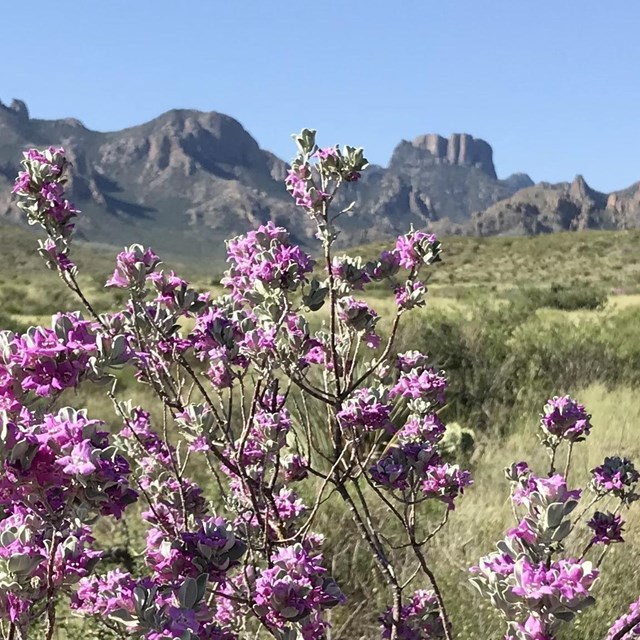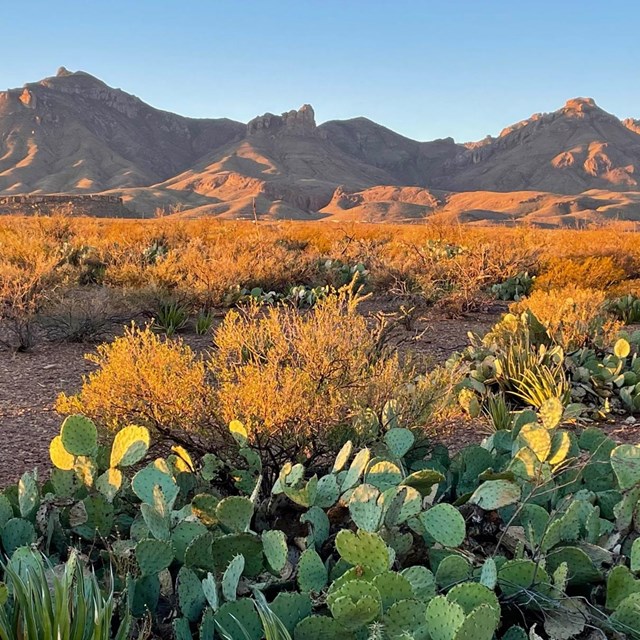
Big Bend National Park was authorized by Congress in 1935 to preserve and protect a representative area of the Chihuahuan Desert along the Rio Grande for the benefit and enjoyment of present and future generations. The park includes rich biological and geological diversity, cultural history, recreational resources, and outstanding opportunities for bi-national protection of our shared natural and cultural heritage.OverviewNameThe Big Bend area of Texas derives its name from its location on the bend of the Rio Grande. The river ceates a natural border that separates the United States from Mexico. Park PurposeBig Bend National Park’s purpose is threefold:
EstablishmentIn 1933, Texas established Texas Canyons State Park using 15 school sections owned by the state. Lands forfeited for non payment of taxes were quickly added and the name was changed to Big Bend State Park, and by October 1933 included about 160,000 acres. On June 20, 1935, President Franklin D. Roosevelt signed a bill that authorized the establishment of Big Bend National Park. On June 6, 1944 a deed for about 700,000 acres was formally presented to President Roosevelt. On June 12, 1944, Big Bend was established as a national park by Congressional Act signed by President Franklin D. Roosevelt. It was designated an International Biosphere Reserve in 1976. Park SignificanceThe park is significant because it contains the most representative example of the Chihuahuan Desert ecosystem in the United States. The park’s river, desert, and mountain environments support an extraordinary richness of biological diversity, including endemic plants and animals, and provide unparalleled recreation opportunities. The geologic features and Cretaceous and Tertiary fossils in Big Bend National Park create opportunities to study many sedimentary and igneous processes. Archeological and historic resources provide examples of cultural interaction in the Big Bend Region and varied ways humans adapted to the desert and river environments. The Rio Grande is life-sustaining for plants, animals, and human inhabitants beyond its banks. Along with three Mexican protected areas, Maderas del Carmen, Cañon de Santa Elena, and Ocampo, Big Bend is now part of one of the largest transboundary protected areas in North America. More than three million acres of Chihuahuan Desert resources, along with more than 200 miles of river, are now under the national protection of the United States and Mexico. Lastly, it was determined that Big Bend’s remoteness has created conditions for the best night sky viewing in the United States. StaffingNational Park ServiceSuperintendent: Anjna O'Connor Volunteers in ParksDedicated Volunteers contribute thousands of hours to Big Bend National Park each year. Big Bend Natural History Association4 permanent / 2 seasonal employees Aramark (concessioner)32 permanent employees Park partnersBig Bend Natural History AssociationA non-profit organization that supports education, research and other programs for the benefit of Big Bend. Financial aid is provided to the park through the sales of interpretive products. Outlets for these products are located in all park visitor centers. Big Bend ConservancyA non-profit organization whose mission is to support, promote, and raise funds for Big Bend National Park in partnership with the National Park Service and other supporters who value the unique qualities found in the Big Bend of the Rio Grande. Natural ResourcesSize801,163 acres (1,252 square miles) ElevationHighest point: Emory Peak; 7,832 feet (2,387 m) River CanyonsSanta Elena Canyon 20 miles (32 km) Rio Grande Wild & Scenic River196 miles of river US/Mexico BorderShared International Border—118 miles (190 km) Landmarks and ElevationsEmory Peak: 7,832 feet (2,387 m) Climate and WeatherFall and spring are usually warm and pleasant. Summers are hot, although temperatures vary greatly between the desert floor and the Chisos Mountains; May and June are the hottest months. Winters are generally mild, although periods of cold weather (including light snow) are possible. Average Annual RainfallChisos Basin: 16.34" Flora and Fauna1,295 species of plants Major Resource Issues:Air Quality/Visibility Cultural ResourcesHuman HistoryEvidence of nearly 12,000 years of human occupation by Paleo-Indian, archaic peoples and a variety of southwestern tribes, including the Chisos, Jumano, Mescalero Apache, and Comanche. Around 1870 ranchers began to migrate to the Big Bend, and by 1900 ranchers, miners and farmers occupied the area. Collection SummaryArcheological objects systematically recovered from within the park’s boundaries and associated field records; historic objects related to the park’s history; herbarium and associated fi eld records; other biological specimens; geological and paleontological specimens. Cataloged Museum Objects413,807 Archeological ResourcesNearly 2,340 sites (8% of park surveyed to date) National Register of Historic PlacesThere are eight National Register of Historic Places sites or districts in Big Bend National Park:
Visitor ServicesBig Bend NP Annual Visitation:Once a relatively unknown National Park, Big Bend has been discovered, and visitation has increased significantly in recent years: 2014: 314,102 **For specific statistical information about Big Bend or any other NPS unit, please visit: NPS Stats Frontcountry CampingChisos Basin Campground: 63 sites Backcountry CampingBackcountry Campsites: 116 Picnic Areas7 (Dugout Wells, Daniels Ranch, Castolon, Cottonwood campground, Chisos Basin, Persimmon Gap, and Santa Elena Canyon) Hiking trails201 miles Roads304 total miles (Paved and gravel)
123 miles of paved roads
45 miles of improved unpaved roads
136 miles of primitive unpaved roads
ConcessionerAramark operates the Chisos Mountains Lodge (72 rooms in motel units and four historic cottages), camper stores at three locations and gas stations at Panther Junction and Rio Grande Village. Major Visitor ActivitiesCamping
|
Last updated: January 22, 2025



